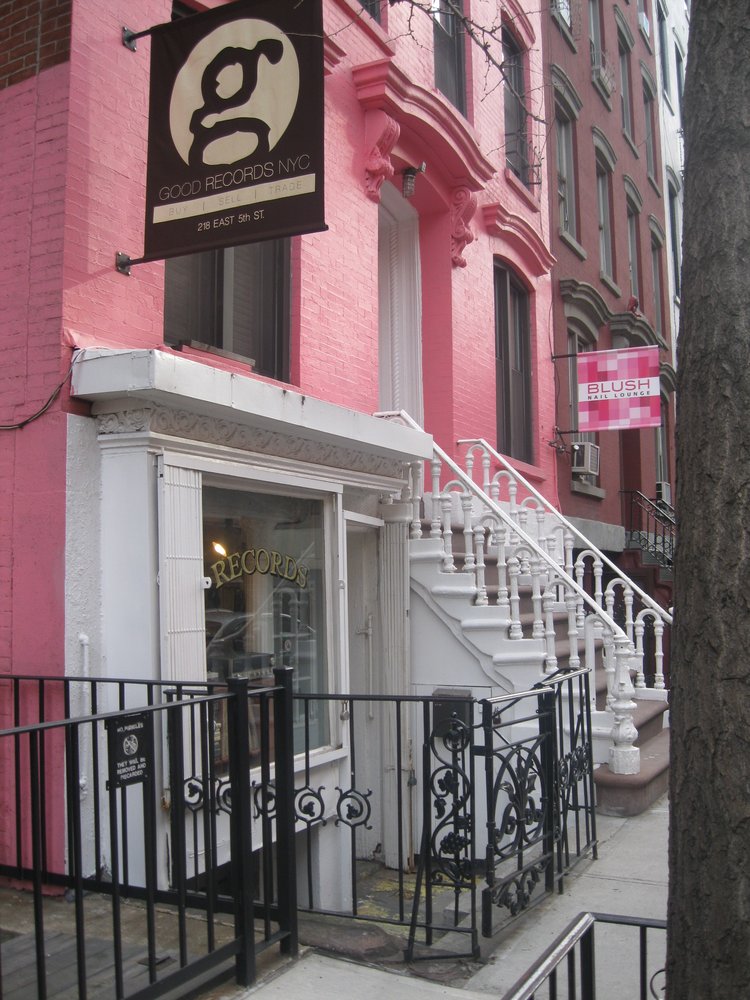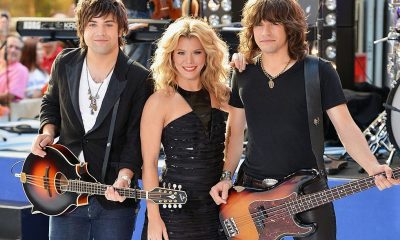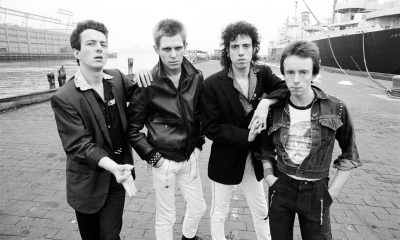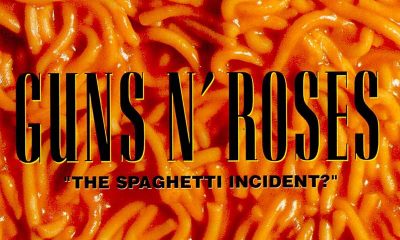Columns
New York City’s Good Records Is a Vinyl Lover’s Paradise

The East Village, bundled neatly between Greenwich and Gramercy, is home to such mini-neighborhoods as Alphabet City (think Prince) and The Bowery (think Joan Baez). It’s the birthplace of the New York punk rock scene, the base for the beatnik movement, and the site of many historical protests and riots. As I ambled along the narrow tree-lined streets with storefronts boasting hand-painted signs from generations past, I came upon a pink building. Not just pink, but cotton candy pink. I felt like Hansel and Gretel must have felt as they emerged from the woods to find the witch’s gingerbread house. It was a record store, simply called Good Records.
I expected an over-the-top queen sashaying across leopard print rugs, boas draped across bejeweled lamp shades. What greeted me instead was a very tasteful, high-end boutique record store filled with not just good records, but very, very good records. I knew that I had stumbled into the collector’s corner of vinyl.
The walls were neatly lined with rare, obscure and weird artifacts; from a double vinyl, single-sided test pressing of the first Led Zeppelin album to a 12-inch Public Enemy record. Then I saw the bargain bins underneath, where everything was a buck. And they were very, very good as well. Simply put, no crap here… Billie Holiday, The Beatles, Radiohead.
Glancing up, there was an Afrika Bambaataa vinyl on the wall, and I was immediately transported back to the 80s, to the punk revolution and to “speak about destruction, speak about destruction, the human race is becoming a disgrace.”
“That record’s a real piece of history,” a voice behind me explained. “It’s a live DJ set that he did before people were even calling it hip hop. This is hip hop on wax. The mixing techniques are really primitive, but that record is basically total genesis of the whole culture on vinyl.”
Meet Jonathan Sklute, owner of Good Records and music aficionado. Born and raised in Berkeley, he ventured to the east coast in 1995 for school. Like many of us transplants, New York captured his heart and he stayed.
Sklute calls Harlem home. “One of the last bastions of old New York,” as he puts it. “It’s a place of amazing architecture with a constant theme of music and cultural heritage and a beautiful spirit of the people. There’s a certain ‘neighborhoodness’ about Harlem, that you miss in other parts of the city.”
Initially, Sklute was working a very New York kind of job; high-stress, high-impact for a financial services company. As time went on, he would look in the mirror and become increasingly dissatisfied with his career. He hated going to work and he knew it was time for a change. Already a passionate record collector and musician, it made perfect sense to open a record store.
But to say that this is just a record store is like saying New York is just a little chilly in the winter. The floors are spotless. The bins (even the bargain bins) are neatly lined and well organized. And the store boasts something New York shops typically have little of—walking space.
“Well, it’s New York City,” he explains. “An international, boutique environment. It’s not like digging in a warehouse. Everything should be mint; it should be clean, in a brand new poly sleeve. It’s only right.”
Good Records is exactly that: Good Records. Not Good CDs or Good Tapes or Good Posters; simply Good Records.
“Today there are a million articles about how the only printed media that’s growing customers is vinyl, and I think the music and the format both got disposable at a certain point. That’s not a judgment, that’s just the way it is. Technology has become more and more capable of condensing our cultural experience into a small space. I think people want something more. A sense of ownership. You can pull out a record and play it and read the liner notes, and it’s just more real.”
The price point for records is typically about $15. But that’s an average between the dollar bins and the high end wall stuff. The most expensive record Sklute ever sold was a rare R&B 45 from the 70s, which brought in $2500. “That’s not huge in the realm of rare 45s; some will crack five or six thousand. But that was my personal best.”
“Part of the reason we specialize in the more obscure, off-the-beaten path kind of stuff,” he explains, “is because people do have access to everything these days. But I believe in vinyl. People believe in vinyl.”
I agree, I tell him. There is magic in the dust and grooves of a record. Memories are stored there. We all remember what we were listening to when we lost our virginity, or when our parents busted us smoking. We remember who was wailing while we nursed our broken hearts. Those are the special songs, and they are preserved with great care and love at Good Records in the Lower East Side.
For me, that music was G&R, visions of tattoos melting in the heat. For Jonathan, that record was by Nas.
“It came out when I was about 15 or 16, at an age when everything was heightened. I remember not only the first time I listened to it. I remember the entire day. We cut class to get on a bus and go to the record store. I think I was the only kid who bought it on vinyl. Rap was still really underground and rebellious. Metal had a tone of rebellion too, but it was on MTV and the radio. Rap wasn’t. Rap was for tough guys and I wanted to be a tough guy. The great thing about this job is that I get to relive those experiences every day. I get to find things that are as good as you’ve ever heard, but you’ve never heard it before. And that’s magic.”
The store itself is not overstuffed or overwhelming. The exposed brick walls and hardwood floors invite you to chat with Sklute and his colleagues. But after watching him sell the funk record he was playing (right off the turntable), after watching him negotiate buying records from a former radio DJ, after hearing little-known stories behind the music and after watching scores of people wander in and out with bags of treasures, a most important question still remained: why pink?
“The landlord told me, and I don’t know how true it is, but his grandfather who originally owned the building was color blind, so when he went to choose the paint, they were all just shades of gray to him, so he just chose a lighter shade of pale. But you can see this bright pink stuff from Brooklyn.”
- Lists13 years ago
Top 10 Country Music Albums of 2010

 Interviews5 years ago
Interviews5 years agoJohn Rich – The Interview

 Song Reviews16 years ago
Song Reviews16 years agoTaylor Swift – “Love Story”

 Interviews5 years ago
Interviews5 years agoHoneyhoney on Hiatus: Revisit our 2008 Interview with Suzanne Santo

 Album Reviews14 years ago
Album Reviews14 years agoAlbum Review: Miley Cyrus – Can’t Be Tamed

 Song Reviews6 years ago
Song Reviews6 years agoThe Band Perry – “Hip To My Heart”

 Columns5 years ago
Columns5 years agoThe Link Between Folk Music’s Past and Present

 Columns5 years ago
Columns5 years agoIs Marketing Killing Rock and Roll?







